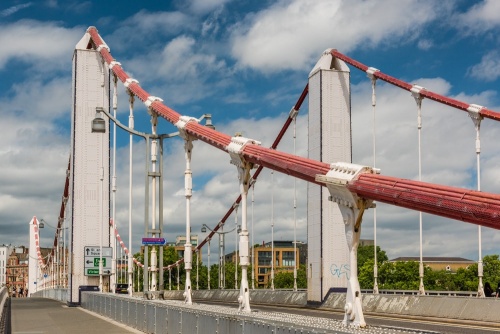
There has been a bridge linking Battersea to Chelsea since 1851, but the present Grade II listed structure was built in 1937. By chance, the site selected for the bridge proved to be the same crossing point used by Julius Caesar in 54 BC.
History
During excavations for the first bridge between Chelsea and Battersea Park, which was being finished at the same time, workmen discovered an enormous number of Roman and Celtic relics, including skeletons and weapons.
The most important relic was a stunning bronze shield dubbed 'The Battersea Shield'. The shield was made from several pieces of bronze sheeting riveted together and decorated with 27 enamel studs. The Battersea Shield is on display in the Museum of London.
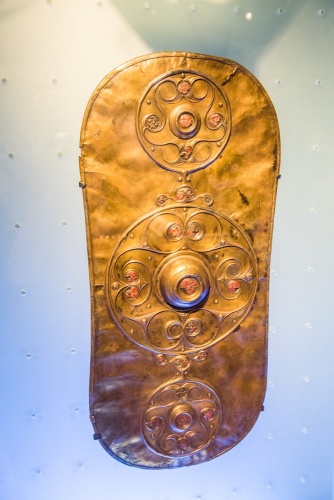
The first Chelsea Bridge was authorised by an Act of Parliament in 1846 and built between 1851-1858 to link the densely populated north bank of the river to the relatively green and unpolluted land south of the river and to the newly designed Battersea Park.
The suspension bridge was designed by the architect Thomas Page and officially opened by Queen Victoria on 31 March 1858. It was named the Victoria Bridge in the Queen's honour and made a beautiful matching pair with the Albert Bridge just upriver.
The First Bridge
The Victoria Bridge was opened to the public on 3 April 1858, but there was a problem.
The new bridge had to be paid for, so a toll was charged. This, not surprisingly, caused a public protest. People complained that the government had opened a free public park in Battersea, but was charging them to get there.
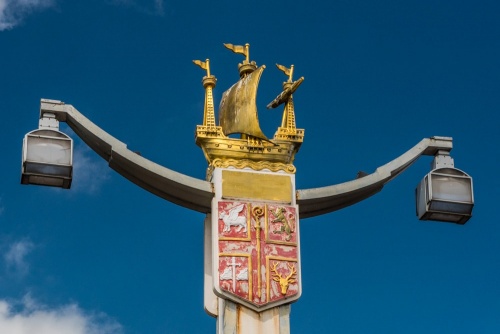
Another issue was bridge lighting. The bridge was illuminated by four lamps, but the lamps were only lit when Queen Victoria was resident in London. Not surprisingly this meant that no one wanted to use the unlit bridge at night.
Parliament gave in to public pressure - a bit - by making the bridge free for pedestrians on Sundays. In 1875 they extended the toll-free period to include all public holidays. In 1879 all three bridges in Battersea (Victoria Bridge, Battersea Bridge, and Albert Bridge) were declared toll-free. In 1880 the bridge was renamed Chelsea Bridge to mark the conclusion of strengthening work.
By the early decades of the 20th century, the expanding population of London and the unforeseen invention of automobiles meant that the bridges could no longer handle the rapidly increasing volume of traffic.
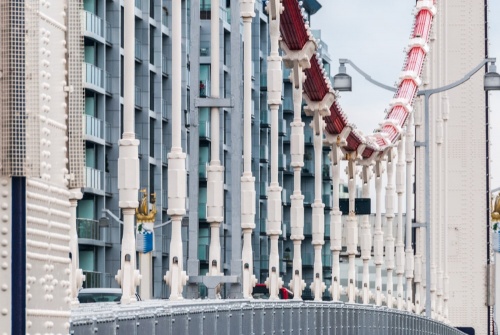
The Second Bridge
The First World War delayed matters and it was not until 1926 that the Royal Commission on Cross River Traffic decided that the old Chelsea Bridge needed to be torn down and replaced with a bridge capable of carrying more traffic. It was not just a traffic issue; the Ministry of Transport wanted to provide employment opportunity for the young men of Battersea,
The new bridge was officially opened on 6 May 1937 by William Lyon Mackenzie King, the Prime Minister of Canada.
Why did a Canadian politician open an English bridge?
Mackenzie King was in London to attend the coronation of King George VI, but his presence at the bridge opening ceremony was a reminder that the new structure was built with material drawn from Commonwealth countries around the world, including Douglas fir trees from Canada used for the bridge decking, asphalt from Trinidad and Tobago for the roadway, steel from Yorkshire and Scotland, and granite from Aberdeen and Cornwall.
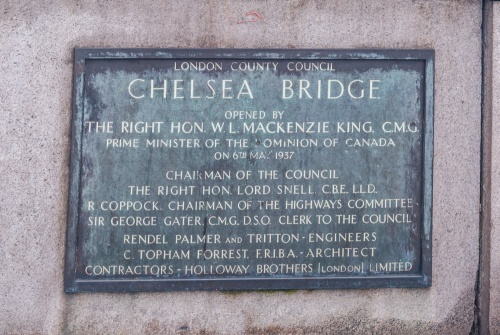
The Bridge
The finished bridge stretched 698 feet (213m) and was 64 feet wide (20.7m). The central span is 352 feet (107.3m), with side spans of 173 feet (52.7m). Remarkably, it came in under budget, at less than GBP 365,000.
The design was by EJ Buckton and HJ Fereday of Rendel, Palmer & Tritton, London and the construction was done by Holloway Brothers. The designers claimed that the new Chelsea Bridge was the first self-anchoring suspension bridge in the UK. The bridge is suspended on steel cables of 37 strands bundled into a hexagon shape. The towers are made of steel set on rocker bearings.
Chelsea Bridge is sparsely decorated compared to the Albert Bridge a few hundred yards away. There are five sets of lampposts decorated with gilded galleons. At each end of the bridge are tail turrets decorated with heraldic shields and more golden galleons.
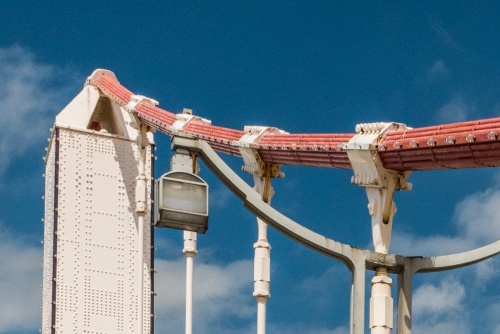
On the outside face is the London County Council crest of St George's Cross, a lion, and wavy lines representing the River Thames. On the inner face of the two southern turrets is a dove of peace, representing Battersea. The north-west turret bears the crest of Chelsea; a winged bull, a lion, a boar, and a stag. The bridge marks the boundary between Chelsea and Westminster so the north-east turret has the Westminster crest of a Tudor rose over a portcullis.
What does a football rivalry have to do with a bridge?
Quite a bit in the case of Chelsea Bridge. In the 1970s the bridge was repainted in red and white. This caused an outcry from supporters of Chelsea Football Club, whose Stamford Bridge ground is just a short distance away. Supporters were irate because red and white were the colours of Arsenal FC, a London rival. In 2007 the bridge was repainted in white with red trim, while the balustrades were painted a greyish blue. Blue is the predominant colour worn by Chelsea.
In the 1950s Chelsea Bridge became a popular gathering place for motorcyclists, who gathered here on Friday nights to race and show off with riding stunts. These gatherings tended to be peaceful, except for one infamous gathering in October 1970 when a huge fight broke out between members of rival biker gangs and 20 people were jailed.
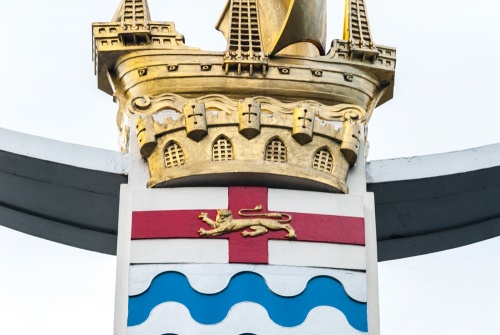
Getting There
Chelsea Bridge is at the southern end of the aptly named Chelsea Bridge road on the north bank of the River Thames and the north end of Queenstown Road on the south bank. The Chelsea Embankment runs across the northern end of the bridge. The nearest underground station is Sloane Square. From the station exit turn left, then left again onto Lower Sloane Street, which turns into Chelsea Bridge Road. From the station to the bridge is roughly 10 minutes walk.
About Chelsea Bridge
Address: Chelsea Embankment,
London,
Greater London,
England
Attraction Type: Landmark - Bridge
Location: At the southern end of Chelsea Bridge Road, a 10-minute walk from Sloane Square underground station.
Location map
OS: TQ285778
Photo Credit: David Ross and Britain Express
Nearest station: ![]() Sloane Square - 0.6 miles (straight line) - Zone: 1
Sloane Square - 0.6 miles (straight line) - Zone: 1
HERITAGE
 We've 'tagged' this attraction information to help you find related historic attractions and learn more about major time periods mentioned.
We've 'tagged' this attraction information to help you find related historic attractions and learn more about major time periods mentioned.
Find other attractions tagged with:
NEARBY HISTORIC ATTRACTIONS
Heritage Rated from 1- 5 (low to exceptional) on historic interest
Carabiniers' Memorial - 0.1 miles (Landmark) ![]()
Battersea Park - 0.4 miles (Garden) ![]()
National Army Museum - 0.5 miles (Museum) ![]()
Saatchi Gallery - 0.6 miles (Museum) ![]()
Chelsea Physic Garden - 0.6 miles (Garden) ![]()
Holy Trinity, Sloane Street - 0.7 miles (Historic Church) ![]()
Albert Bridge - 0.7 miles (Landmark) ![]()
Carlyle's House - 0.8 miles (Historic Building) ![]()
Nearest Holiday Cottages to Chelsea Bridge:
Leaves Green, Greater London
Sleeps: 6
Stay from: £871 - 3614
More self catering near Chelsea Bridge



